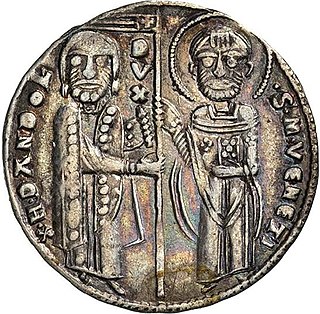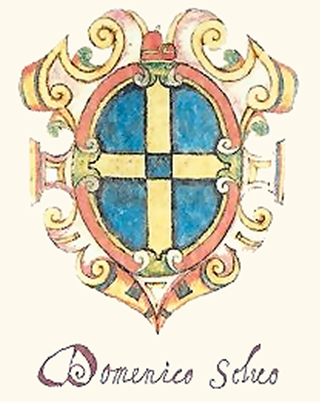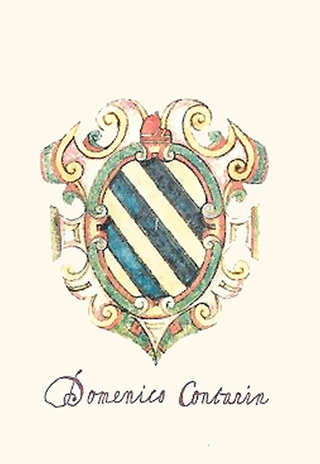Related Research Articles

Enrico Dandolo was the Doge of Venice from 1192 until his death. He is remembered for his avowed piety, longevity, and shrewdness, and is known for his role in the Fourth Crusade and the Sack of Constantinople. Dandolo died in 1205 in Constantinople and was buried at the Hagia Sophia.

The Patriarch of Venice is the ordinary bishop of the Archdiocese of Venice. The bishop is one of only four patriarchs in the Latin Church of the Catholic Church. The other three are the Patriarch of Lisbon, the Patriarch of the East Indies and the Latin Patriarch of Jerusalem. Presently, the only advantage of this purely formal title is the bishop's place of honor in papal processions. In the case of Venice, an additional privilege allows the patriarch, even if he is not a cardinal, the use of the colour red in non-liturgical vestments. In that case, the red biretta is topped by a tuft, as is the custom with other bishops who are not cardinals.

The Contarini is one of the founding families of Venice and one of the oldest families of the Italian Nobility. In total eight Doges to the Republic of Venice emerged from this family, as well as 44 Procurators of San Marco, numerous ambassadors, diplomats and other notables. Among the ruling families of the republic, they held the most seats in the Great Council of Venice from the period before the Serrata del Maggior Consiglio when Councillors were elected annually to the end of the republic in 1797. The Contarini claimed to be of Roman origin through their patrilineal descendance of the Aurelii Cottae, a branch of the Roman family Aurelia, and traditionally trace their lineage back to Gaius Aurelius Cotta, consul of the Roman Republic in 252 BC and 248 BC.

This is a list of the Patriarchs of Grado.

Domenico Selvo was the 31st Doge of Venice, serving from 1071 to 1084. During his reign as Doge, his domestic policies, the alliances that he forged, and the battles that the Venetian military won and lost laid the foundations for much of the subsequent foreign and domestic policy of the Republic of Venice. He avoided confrontations with the Byzantine Empire, the Holy Roman Empire, and the Roman Catholic Church at a time in European history when conflict threatened to upset the balance of power. At the same time, he forged new agreements with the major nations that would set up a long period of prosperity for the Republic of Venice. Through his military alliance with the Byzantine Empire, Emperor Alexios I Komnenos awarded Venice economic favors with the declaration of a golden bull that would allow for the development of the republic's international trade over the next few centuries.

Domenico Contarini was the 30th Doge of Venice. His reign lasted from his election in 1043 following the death of Domenico Flabanico until his own death in 1071. During his reign, the Venetians recaptured Zadar and parts of Dalmatia that had been lost to the Kingdom of Croatia in the previous few decades. The Venetian naval fleet was heavily built up during his reign, the economy thrived, and the Republic of Venice had reasserted its control over much of the Mediterranean Sea.

Vital I Michiel was a Doge of Venice; he was the 33rd traditional Doge of the Republic of Venice. A member of one of the so-called “twelve apostolic” families, he was married to Felicia Cornaro, who had influence on his politics.

San Nicolò al Lido refers to both the San Nicolò Church and most importantly to its annexed Monastery of San Nicolò located in Venice, northern Italy. The two Catholic institutions are located in the northern part of the Lido di Venezia and house the relics of Saint Nicholas, patron of sailors. From this church, the traditional thanksgiving Mass of the Sposalizio del Mare is celebrated. The complex houses monks of the Franciscan order.
Giovanni Orseolo (981-1006/7) was the first Venetian to hold power in Dalmatia, holding the title of Dux Dalmatiae.

Vitale II Michiel was Doge of Venice from 1156 to 1172.
This article presents a detailed timeline of the history of the Republic of Venice from its legendary foundation to its collapse under the efforts of Napoleon.

The Diocese of Castello, originally the Diocese of Olivolo, is a former Roman Catholic diocese that was based on the city of Venice in Italy. It was established in 774, covering the islands that are now occupied by Venice. Throughout its existence there was tension between the diocese, the Patriarchate of Grado to which it was nominally subordinate, and the Doge of Venice. Eventually in 1451 the diocese and the patriarchate were merged to form the Archdiocese of Venice.

Theodore the Martyr refers to the two saints Theodore of Amasea and Theodore Stratelates, two important military saints of the Byzantine period. The two saints are likely identical in origin, the veneration of Theodore of Amasea is ascertained for the late 4th century, while the tradition of Theodore Stratelates develops from that of Theodore of Amasea by the 9th century. There is a Coptic Life of Theodore the General, which places his martyrdom in Egypt. In Coptic tradition, the saint is also known as Saint Theodore of Shwtp.
Enrico Dandolo was Patriarch of Grado, Italy, from 1134 to 1182. A member of a noble Venetian Dandolo family, after his appointment he put the interests of the church ahead of all other concerns.
Events during the year 1108 in Italy.

In 1268, the Byzantine Empire and the Republic of Venice agreed to temporarily end hostilities which had erupted after the Byzantine recovery of Constantinople by Emperor Michael VIII Palaiologos in 1261.
The timeline of the Latin Empire is a chronological list of events of the history of the Latin Empire—the crusader state that developed on the ruins of the Byzantine Empire after the Fourth Crusade in the 13th century.
The Byzantine–Venetian treaty of 1277 was an agreement between the Byzantine Empire and the Republic of Venice that renegotiated and extended for two years the previous 1268 treaty between the two powers. The agreement was beneficial for both sides: Byzantine emperor Michael VIII Palaiologos kept the Venetians and their fleet from participating in the attempts of Charles of Anjou to organize an anti-Byzantine crusade, while the Venetians were able to retain their access to the Byzantine market, and even augment their trading privileges by gaining direct access to the Black Sea and the right to their own quarters in Constantinople and Thessalonica. Furthermore, they were able to stop the Byzantine reconquest of Venetian-aligned territories in the Aegean, although the treaty explicitly allowed both sides to continue fighting for control of the island of Euboea (Negroponte). Nevertheless, the agreement's short duration made clear that for both parties, it was a temporary expedient. After the treaty expired, the Venetians allied with Charles of Anjou, but their plans were thwarted by the outbreak of the War of the Sicilian Vespers in 1282, forcing Venice once more to renew the peace with the Byzantines in 1285.
This is an alphabetical index of people, places, things, and concepts related to or originating from the Republic of Venice. Feel free to add more, and create missing pages.

Saint Mark's relics, the putative remains of Mark the Evangelist, are held in St Mark's Basilica in Venice, Italy.
References
Citations
- 1 2 Nicol 1992, p. 72.
- 1 2 Cheney 2013.
- ↑ Ross 2012.
- ↑ Venice: Catholic Encyclopedia.
- ↑ Nicol 1992, p. 71.
- ↑ Batty 1820, p. 169.
Sources
- Batty, Elizabeth Frances (1820). Italian Scenery: From Drawings Made in 1817. Rodwell & Martin. p. 169 . Retrieved 2013-11-27.
- Cheney, David M. (21 August 2013). "Bishop Enrico Contarini". Catholic Hierarchy. Retrieved 2011-11-27.[ self-published source ]
- Nicol, Donald M. (1992-05-07). Byzantium and Venice: A Study in Diplomatic and Cultural Relations. Cambridge University Press. ISBN 978-0-521-42894-1 . Retrieved 2013-11-26.
- Ross, Kelley L. (2012). "Patriarchs of Aquileia, Grado, and Venice" . Retrieved 2013-11-26.
- Venice . Retrieved 2013-11-26.
{{cite book}}:|work=ignored (help)